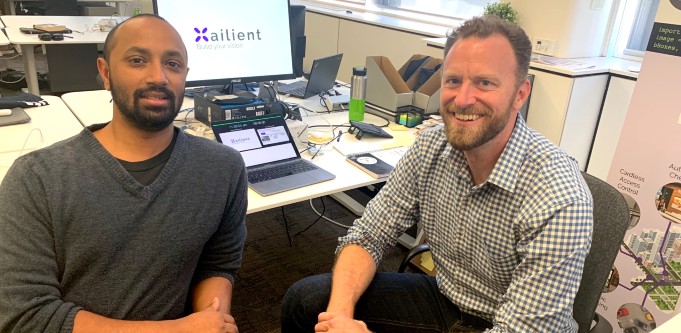
Xailient co-founders Shivy Yohanandan and Lars Oleson. Source: supplied.
Having graduated from Antler’s startup generator, Internet-of-Things (IoT) startup Xailient is setting out to spread its smart sensors all over the world. And it was all inspired by a bionic eye.
Xailient combines artificial intelligence and IoT technologies to allow computers to ‘see’, make sense of and reacting to the world around them.
“We can make things be smart enough to see the world around them and understand it,” co-founder Lars Oleson tells StartupSmart.
“Today, we can teach them to find people and faces. And we’re working with customers to allow them to find anything.”
Already, there are IoT sensor hardware products on the market. But they’re not intelligent, Oleson explains.
The Xailient sensors will be able to process input information without having to send it to a server and back, he adds.
“It’s much cheaper, but it’s also much faster.”
The technology was born out of co-founder Shivy Yohanandan’s PhD research at RMIT.
Having originally studied neuroscience, evolutionary biology and engineering, Yohanandan later worked on a project building Australia’s first bionic eye — an implant giving sight to the blind.
“Then I got interested in trying to give machines vision, inspired by human vision,” Yohanandan says.
He started working on his PhD “to try and bridge the walls between neuroscience and AI”, and ultimately figured out what would become the key to Xailient’s technology — how it is that humans and animals can see so efficiently.
“The key is that efficiency,” he says.
“That’s why we’re able to then fit this onto small devices.”
Oleson, on the other hand, is a serial entrepreneur, who has worked in enterprise software for 20 years and has built and sold three different companies, one of which was acquired by Alipay.
The pair met through the Antler program, and as one of the final 12 startups, secured $100,000 in seed funding.
A grand machine vision
Currently, the tech is in beta testing with a select few clients. However, the co-founders expect to have an open beta up and running within the next six months or so.
And Yohanandan has big dreams for what this technology could do.
“The way we see the IoT sphere taking shape, adding intelligence is kind of scaling the human form,” he says.
Our bodies have a centralised brain making all the decisions, but also millions of sensors all over our body, sending messages to the brain.
“You can almost think of them as IoT sensors as well.”
If IoT devices can report back efficiently and in real-time, “you can all of a sudden imagine managing the Earth’s resources more efficiently”, Yohanandan says.
“If you’ve got IoT devices in real-time, continuously streaming analytics information to some servers, or the cloud, or a distributed brain, that could make decisions much faster than humans can, we could manage resources more efficiently, minimise global warming, that sort of stuff,” he adds.
“That’s the grand picture that we see. That’s Xailient’s mission and vision, ultimately.”
No robot takeover today
You would be forgiven if you think this all sounds a bit like the beginning of the robot takeover, or something you might find in a futuristic horror film.
But, when it comes to data privacy, having all the processing happen within the device itself could actually be a good thing.
“We have the opportunity to provide privacy at the edge,” Oleson explains.
“We can detect events happening on the camera, from the IoT device, and remove personally identifiable information in real-time.”
This allows the sensors to gather analytics information, for example on traffic conditions or footfall in a retail space, while removing and personally identifiable information.
People’s faces never get sent to the cloud, which is where the vulnerability typically sits.
There’s also a possibility that facial data can be encrypted and only released if it’s required to be, legally.
“We could provide that kind of cryptographic security, and ultimately policymakers can decide who and when and under what circumstances that information can be re-released.”
These are already very relevant considerations for the European market, where the General Data Protection Regulation (GDPR) enforces strict privacy measures for EU citizens.
But, privacy shouldn’t only be the responsibility of the tech companies, Oleson suggests.
“Ultimately, I’m not the policymaker,” he says.
“We as a society can have a conversation and decide how much we want to go in the direction of GDPR or other paradigms that we’ve seen globally.
“And I think it’s good then for technologists to provide those solutions, and to provide them in a way that’s auditable and trackable and provable.”
That said, Xailient is already operating to its own internal code of ethics: machines should do no harm, they should not allow harm through inaction, and they need to obey people.
A lot of tech “has its DNA in sci-fi”, Oleson says.
Through film and TV, we have seen some of the worst-case scenarios of letting AI run wild.
“Going back to some of the thought experiments we’ve had for the past 50 years … this is not a bad starting place.”
StartupSmart was invited to Antler HQ as the official media partner of Antler Demo Day 2019.
NOW READ: A $23 trillion opportunity: Why Australia must embrace the AI revolution


COMMENTS
SmartCompany is committed to hosting lively discussions. Help us keep the conversation useful, interesting and welcoming. We aim to publish comments quickly in the interest of promoting robust conversation, but we’re a small team and we deploy filters to protect against legal risk. Occasionally your comment may be held up while it is being reviewed, but we’re working as fast as we can to keep the conversation rolling.
The SmartCompany comment section is members-only content. Please subscribe to leave a comment.
The SmartCompany comment section is members-only content. Please login to leave a comment.